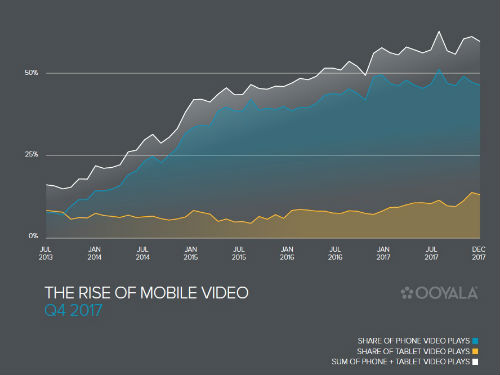Video Continues to Mobilize: Study

Consumer viewing continues to migrate to mobile devices as they slowly drift away from the TV screen.
Maintaining its double-digit growth path, mobile now makes up 60.3% of all video plays, according to Ooyala’s Global Video Index for Q4 2017, which based its findings on anonymized online video metrics of the bulk of Ooyala’s 500-plus customers around the world. That’s up from a previous high of 58.3% in the previous quarter.
Ooyala, a maker of multiscreen video software and systems, attributed the rate of growth, which ticked up 11% year-over-year, on a jump in tablet views alongside steady viewership increases on smartphones.
RELATED: What’s Next for Ooyala? (subscription required)
As a comparative look back at the rapid, increasing power of mobile video, Ooyala points out that mobile video plays made up just 17.14% of the total in Q4 2013.
The share of video starts on smartphones rose 1.7% to 47.5% in Q4, while views on tablets reached nearly 12.8% of all views in the quarter, a record for that platform, Ooyala said, noting that views on tablets jumped by more than 24% from Q3 and 67.7% from a year ago.
Ooyala also found that medium-form (5 to 20 minutes) and long-form content (20 minutes-plus) ate up more than half of all viewing time across all screens.
Multichannel Newsletter
The smarter way to stay on top of the multichannel video marketplace. Sign up below.
On connected TVs, long-form time viewed in Q4 chimed in at 98.9%, about the same from the previous quarter, and up from 96% in the year-ago period. Long-form viewing on tablets followed, at 62%.
Ooyala’s study also took a look at the multiscreen advertising landscape, finding that broadcaster pre-roll ad impressions on smartphones topped 54% in Q4, accelerating from 39% in Q3 and 29% in Q2.
Completion rates of pre-roll ads varied by screen type. In Q4, completion rates in this category on PCs were 87%, up slightly from Q3, versus 91% for connected TVs (a number that’s been flat for three quarters), and 86% on smartphones, up from 84% in Q3.
